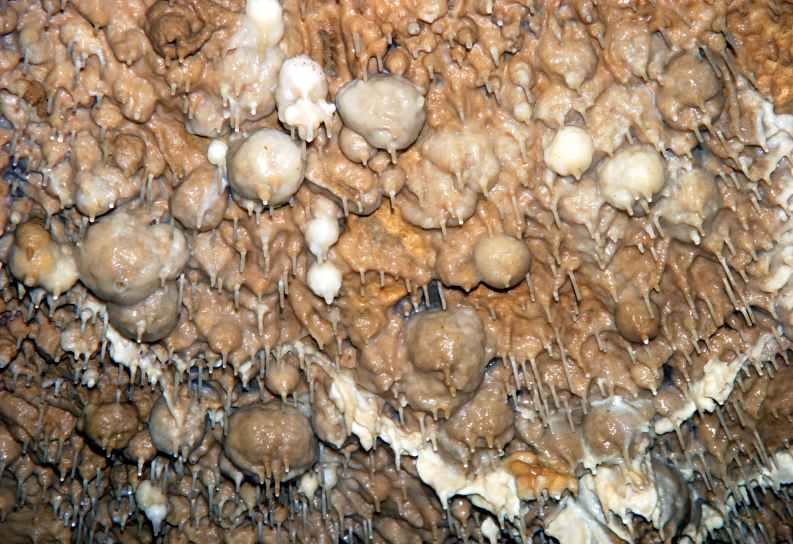Sloup–šošůvka Caves - Natural conditions
GEOLOGICAL DEVELOPMENT OF THE AREA

The Moravian Karst is formed by limestones from Middle to Late Devonian. These organogenous sea sediments form the Josefov, Lažánky, Vilémovice and Křtiny formations of limestones. Their total thickness is estimated at 500–1,000 m. In the west they lie on old deep-mined volcanic rocks – granodiorites of the Brno Massif; in the east they are overlapped by Culm greywackes and shales of Carboniferous age. After the Palaeozoic sea dereliction and mighty Variscan folding which hit the whole Bohemian massif, the limestones began to undergo intensive karstification. It was during the Mesozoic and Tertiary eras it was again interrupted by short-term sea floods, which reflected orogenic unrest of the main phases of mighty Alpine folding. The Mesozoic Sea then left its carbonate sediments with fossils of ammonites, belemnites and other sea animals, e.g. in the surroundings of Olomučany. Vari-coloured layers of kaolinitic sands and clays filling deep karst pockets (so-called sand pipes) survived from the Early Cretaceous Period in the surroundings of the village of Rudice. It is a residue of intensive weathering processes when a tropical climate dominated here. The following development of the Moravian Karst was influenced by the Badenian sea flooding in the Tertiary. Deep karst canyons with the oldest cave systems at that time were filled with young clay sediments, which basically changed the hydrographic development of the Moravian Karst. From the middle Tertiary, the Moravian Karst gradually changed to the present form.
STALACTITE AND STALAGMITE DECORATION OF THE SLOUP-ŠOŠŮVKA CAVES
The stalactite and stalagmite decoration is formed by the precipitation of limestone dissolvedin dripping water getting into the caves from the surface by gradual infiltration. There are various cave fillings in the Sloup-Šošůvka Caves. In addition to numerous stalactites, stalagmites, cave waterfalls and sinter crusts, so-called moonmilk coating can also be found here. The formation of this peculiar sinter pulpy material, which is formed in a process supported by microorganisms, is not quite clear. In previous centuries it was scraped from the walls of the Sloup Cave by local residents for its supposed medicinal properties. Spherolitic stalagmites called “wasp cupolas” are a curiosity of the Šošůvka Caves (see Fig. above). Their crystalline structure consists of layers imitating the unevenness of the rock walls.
The Šošůvka part together with Eliška's Cave can be counted among spaces with the most beautiful and best preserved stalactite decoration. The symbol of the Sloup-Šošůvka Caves is the so-called “Svícen” (Candelabrum) – a unique stalagmite formation. Its lumpy lower part was formed under the lake surface and the upper smooth carrot-shaped part was grown above water.
Bat species overwintering in THE Sloup-Šošůvka Caves (according to Dr. M. Kovařík)
|
English name |
Latin name |
Note |
|
Greater Mouse-eared Bat |
Myotis myotis |
95 % of all species |
|
Lesser Horseshoe Bat |
Rhinolophus hipposideros |
|
|
Geoffroy's Bat |
Myotis emarginatus |
|
|
Natterer's Bat |
Myotis nattereri |
|
|
Daubenton's Bat |
Myotis daubentoni |
|
|
Barbastrelle |
Barbastella barbastellus |
|
|
Brown Big-eared Bat |
Plecotus auritus |
|
|
Grey Big-eared Bat |
Plecotus austriacus |
|
|
Whiskered Bat |
Myotis mystacinus |
|
|
Lesser Mouse-eared Bat |
Myotis blythi |
|
|
Bechstein's Bat |
Myotis bechsteini |
|
|
Pond Bat |
Myotis dasycneme |
is a rare species |
|
Parti-coloured Bat |
Vespertilio murinus |
stated in the past |
|
Northern Bat |
Eptesicus nilssoni |
very rare in the area of the Moravian Karst |
|
Serotine |
Eptesicus serotinus |
rarely overwintering in caves |
|
Common Pipistrele |
Pipistrellus pipistrellus |
found randomly in the cave, commonly overwinter in buildings |
|
Greater Horseshoe Bat |
Rhinolophus ferrumequinum |
very rare in the area of the Moravian Karst |